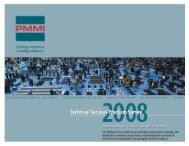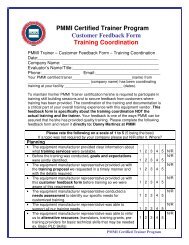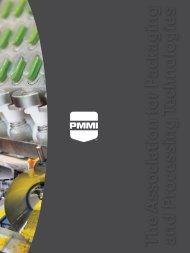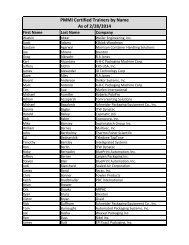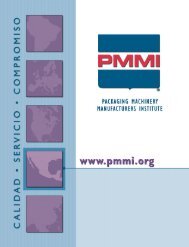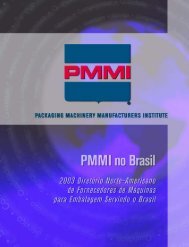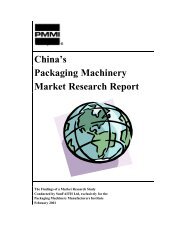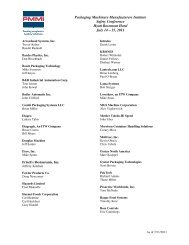You also want an ePaper? Increase the reach of your titles
YUMPU automatically turns print PDFs into web optimized ePapers that Google loves.
iii<br />
On<br />
<strong>the</strong> show floor, The Packaging Posse members observed several trends among <strong>the</strong> thousands<br />
of technologies and innovaons.<br />
The Packaging Paradigm is Shifting<br />
With <strong>the</strong> connuing growth in <strong>the</strong> number and variety of flexible packaging-related exhibits, <strong>the</strong> 2012<br />
show clearly demonstrated a shi in <strong>the</strong> way packagers see packaging operaons. Lightweight flexible<br />
packaging formats are gradually replacing <strong>the</strong> pracce of having converters produce and ship a limited<br />
range of container shapes and sizes to <strong>the</strong>ir customers. Instead, <strong>the</strong> flexible formats are formed inline<br />
with filling, sealing, labeling and packing operaons .<br />
Evolution in <strong>the</strong> Digital Revolution<br />
Mechanical systems are giving way to digital controls, brushless DC motors, servos and o<strong>the</strong>r modern<br />
control equipment. Today’s machinery can accomplish tasks such as automacally troubleshoong, re-seng<br />
and/or repairing itself without human intervenon. It can (and does) record producon sengs for quicker, simpler, rela-‐<br />
vely-trouble free changeovers . Maintenance manuals and data are pre-loaded into <strong>the</strong> machine’s PLC or PC memory for use in<br />
control and communicaons. And, to an increasing degree, machines are connecng with <strong>the</strong> original equipment manufacturer<br />
(OEM) online for trouble shoong or to implement modificaons, reducing or eliminang <strong>the</strong> need for onsite technical service.<br />
“Sustainability” Redefined<br />
“Sustainable packaging” at PACK EXPO Internaonal 2012 predominantly revolved around using fewer resources. On <strong>the</strong> systems<br />
side of <strong>the</strong> equaon, reducing ulity usage — energy, compressed air, reclaiming/reusing radiant heat — and <strong>the</strong> resulng cost<br />
was a recurring <strong>the</strong>me. On <strong>the</strong> materials side, “sustainable” packages ei<strong>the</strong>r used less material than <strong>the</strong>ir predecessors, were reus-able<br />
or were composed of recycled content. Biopolymer materials and packages were noceably less prevalent than in recent<br />
years, possibly because of producon and funconal issues, costs in comparison to petrochemical materials, and <strong>the</strong> maturaon of<br />
<strong>the</strong> technology.<br />
Flexible Pouches Move Beyond Kids’ Drinks<br />
Flexible pouches are making inroads into previously unexplored territories including paint and medical supplies and as replace-ments<br />
for more rigid packaging opons, such as paperboard cartons for cookies and confecons. Innovave pouch formats includ-ed<br />
single-serving cookie and snack packs, handles on larger pouches to make dispensing easier and new fitments for ease of use.<br />
Pouches have evolved into a mainstream packaging opon and a viable alternave to cans, glass, or plasc boles. Secondary<br />
products, such as mulpack equipment, plus <strong>the</strong> low-cost flexibility inherent in pouch design offer a wide range of soluons for<br />
consumer convenience, making <strong>the</strong> pouch a viable choice for almost any product.<br />
More Efficient, Easier to Maintain, Networked Equipment<br />
Advances in equipment automaon improved producon speed, output quality, ulity and flexibility while reducing <strong>the</strong> need for<br />
human labor. There was a connued focus on integrated machines, modular design and high level of operaonal flexibility with<br />
more offerings of line simulaon and line control/monitoring soware. Also noted:<br />
<br />
<br />
<br />
<br />
Increased use of touch screen controls with icons and images, ra<strong>the</strong>r than text, for ease of use without language barriers;<br />
Simplificaon of equipment to reduce changeover me, maintenance and cleaning;<br />
Conversion from mechanical/pneumac to all electric/electronic operaons.<br />
Significant machine control programming to link with serializaon efforts.<br />
Robotics on <strong>the</strong> Rise<br />
TRENDS<br />
Robots are increasingly used for a growing range of “fine motor skill” primary packaging applicaons. Robots in case packaging<br />
operaons might use long arms to handle several producon lines simultaneously, or customized grippers that provide addional<br />
flexibility. Robots can be converted fairly easily as well, as applicaons and needs change.<br />
TODAY’S MARKET DEMANDS; TOMORROW’S PACKAGING TRENDS



